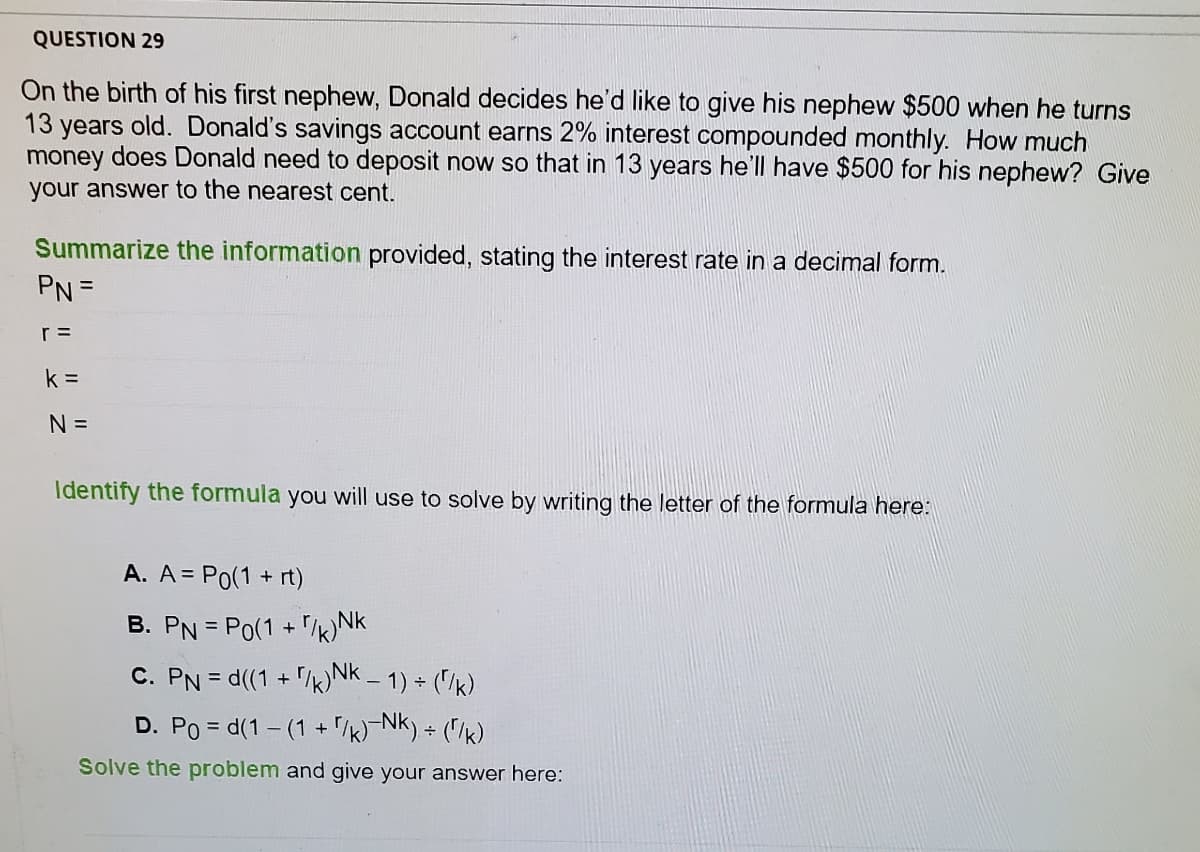QUESTION 29 On the birth of his first nephew, Donald decides he'd like to give his nephew $500 when he turns 13 years old. Donald's savings account earns 2% interest compounded monthly. How much money does Donald need to deposit now so that in 13 years he'll have $500 for his nephew? Give your answer to the nearest cent. Summarize the information provided, stating the interest rate in a decimal form. PN = r = k = N = Identify the formula you will use to solve by writing the letter of the formula here: A. A = Po(1 + rt) B. PN = Po(1 +/NK %3D C. PN = d((1 + /k) Nk – 1) + ("/k) D. Po = d(1 - (1 + /k)¬Nk) + ("/k) Solve the problem and give your answer here:
QUESTION 29 On the birth of his first nephew, Donald decides he'd like to give his nephew $500 when he turns 13 years old. Donald's savings account earns 2% interest compounded monthly. How much money does Donald need to deposit now so that in 13 years he'll have $500 for his nephew? Give your answer to the nearest cent. Summarize the information provided, stating the interest rate in a decimal form. PN = r = k = N = Identify the formula you will use to solve by writing the letter of the formula here: A. A = Po(1 + rt) B. PN = Po(1 +/NK %3D C. PN = d((1 + /k) Nk – 1) + ("/k) D. Po = d(1 - (1 + /k)¬Nk) + ("/k) Solve the problem and give your answer here:
Intermediate Algebra
10th Edition
ISBN:9781285195728
Author:Jerome E. Kaufmann, Karen L. Schwitters
Publisher:Jerome E. Kaufmann, Karen L. Schwitters
Chapter11: Exponential And Logarithmic Functions
Section11.2: Applications Of Exponential Functions
Problem 26PS
Related questions
Question

Transcribed Image Text:QUESTION 29
On the birth of his first nephew, Donald decides he'd like to give his nephew $500 when he turns
13 years old. Donald's savings account earns 2% interest compounded monthly. How much
money does Donald need to deposit now so that in 13 years he'll have $500 for his nephew? Give
your answer to the nearest cent.
Summarize the information provided, stating the interest rate in a decimal form.
PN =
r =
k =
N =
Identify the formula you will use to solve by writing the letter of the formula here:
A. A = Po(1 + rt)
B. PN = Po(1 + /NK
%3D
C. PN = d((1 + /k) Nk – 1) + ("/k)
D. Po = d(1 - (1 + /k)¬Nk) + ("/k)
Solve the problem and give your answer here:
Expert Solution
This question has been solved!
Explore an expertly crafted, step-by-step solution for a thorough understanding of key concepts.
Step by step
Solved in 3 steps with 2 images

Recommended textbooks for you

Intermediate Algebra
Algebra
ISBN:
9781285195728
Author:
Jerome E. Kaufmann, Karen L. Schwitters
Publisher:
Cengage Learning

College Algebra
Algebra
ISBN:
9781305115545
Author:
James Stewart, Lothar Redlin, Saleem Watson
Publisher:
Cengage Learning


Intermediate Algebra
Algebra
ISBN:
9781285195728
Author:
Jerome E. Kaufmann, Karen L. Schwitters
Publisher:
Cengage Learning

College Algebra
Algebra
ISBN:
9781305115545
Author:
James Stewart, Lothar Redlin, Saleem Watson
Publisher:
Cengage Learning

